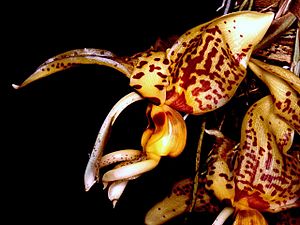Stanhopea shuttleworthii facts for kids
Quick facts for kids Stanhopea shuttleworthii |
|
|---|---|
 |
|
| A beautiful Stanhopea shuttleworthii flower | |
| Scientific classification | |
| Genus: |
Stanhopea
|
| Species: |
shuttleworthii
|
The Stanhopea shuttleworthii is a special kind of orchid that grows only in Colombia. This means it is endemic to Colombia, specifically found in the Tolima region. It's like a unique treasure of nature, found nowhere else in the world!
Contents
Discovering the Stanhopea shuttleworthii Orchid
The Stanhopea shuttleworthii is a fascinating plant. It belongs to the Stanhopea group of orchids. These orchids are known for their amazing, often fragrant, flowers.
What Makes Orchids Special?
Orchids are one of the largest families of flowering plants on Earth. They have been around for millions of years!
- Unique Flowers: Orchid flowers often have a very distinct shape. They usually have three petals and three sepals. One petal is often much larger and shaped differently, called the "lip" or "labellum." This lip helps attract pollinators like insects.
- Growing Habits: Many orchids, including the Stanhopea shuttleworthii, are epiphytes. This means they grow on other plants, like trees, but they don't harm them. They use the trees for support to reach sunlight. They get their water and nutrients from the air, rain, and decaying leaves around them.
- Amazing Scents: Some orchids, especially those in the Stanhopea group, are famous for their strong and often beautiful smells. These scents help them attract specific insects for pollination.
Where Does This Orchid Live?
The Stanhopea shuttleworthii is found only in the Tolima area of Colombia. This region has the perfect climate and environment for this specific orchid to thrive.
- Tropical Climate: Colombia is a country with a warm, humid, and tropical climate. This is ideal for many orchid species.
- Rainforest Homes: Many orchids live in rainforests, where there is plenty of moisture and shade. These forests are like natural nurseries for these beautiful plants.
The Life Cycle of an Orchid
Orchids have an interesting way of growing and reproducing.
How Orchids Reproduce
Orchids reproduce using seeds, but their seeds are tiny, like dust!
- Pollination: Just like other flowering plants, orchids need to be pollinated to make seeds. Insects, birds, or even bats can help carry pollen from one flower to another. For Stanhopea orchids, male bees are often the main pollinators.
- Seed Pods: After pollination, the orchid flower develops a seed pod. When the pod ripens, it releases thousands, or even millions, of tiny seeds.
- Fungus Friends: Orchid seeds don't have much food stored inside them. To grow, they need help from a special type of fungus in the soil. This fungus provides the nutrients the tiny seed needs to sprout and grow into a new plant.
Growing and Blooming
It can take many years for an orchid seedling to grow into a mature plant that can produce flowers.
- Slow Growth: Orchids often grow slowly, especially in their early stages.
- Flowering Time: Once mature, the Stanhopea shuttleworthii will produce its unique and beautiful flowers. These flowers might only last for a few days, but they are truly spectacular!
Protecting Our Orchids
Because the Stanhopea shuttleworthii only grows in one specific area, it's very important to protect its natural home.
- Habitat Loss: One of the biggest threats to orchids is the loss of their habitat. When forests are cut down, these plants lose their homes.
- Conservation Efforts: Many people and organizations are working hard to protect orchids and their environments. This includes setting up special reserves and educating people about the importance of these plants.
- Why It Matters: Protecting orchids helps protect the entire ecosystem. Every plant and animal plays a role in keeping our planet healthy.
See also
 In Spanish: Stanhopea shuttleworthii para niños
In Spanish: Stanhopea shuttleworthii para niños

